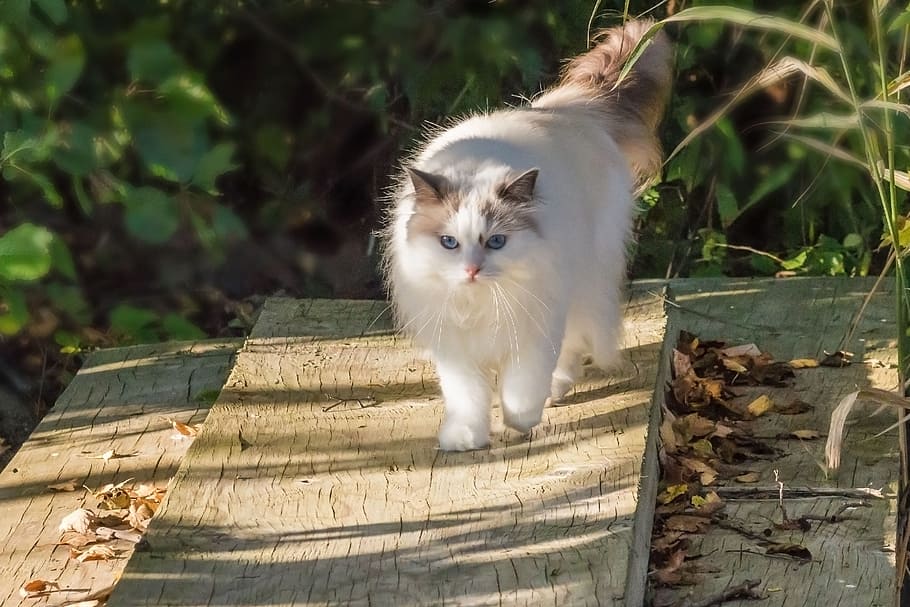Ragdoll cats are beloved by many for their gentle and affectionate nature. However, as with any pet, they can develop behavior problems. This article discusses the 10 most common behavior problems that Ragdoll cats may exhibit. We will provide explanations for each problem. We will offer solutions to help you address these issues with your feline friend.
Common Ragdoll Cat Behavior Problems Explained and Solved
- Aggression
- Ragdoll Cat Litter Box Issues
- Separation Anxiety
- Excessive Meowing
- Furniture Scratching
- Picky Eating
- Hairballs
- Lack of Stimulation
- Health Issues
- Weight Gain Issues
1. Aggression
Ragdoll cats are known for their gentle and docile nature. However, aggression can be seen in some Ragdolls, causing distress to both the feline and the owners.
Causes of Aggression
There are various reasons why Ragdoll cats may exhibit aggressive behavior. Some of the reasons include:
- Medical conditions
- Fear and anxiety
- Territorial behavior
- Inappropriate interaction
If you notice your Ragdoll becoming aggressive, it’s important to identify the cause. Then, address it.
Addressing and Managing Aggressive Behavior
Addressing and managing aggressive behavior in Ragdoll cats requires patience and understanding. Here are some tips for dealing with aggression in your Ragdoll:
- Identify the trigger for the aggression and avoid it if possible.
- Provide a safe and quiet space for your Ragdoll to retreat to when feeling threatened.
- Ensure your Ragdoll has plenty of mental and physical stimulation to avoid boredom and frustration.
- Redirect their behavior using positive reinforcement and offering treats.
2. Ragdoll Cat Litter Box Issues
As a Ragdoll cat owner, you may encounter toilet problems. Your cat may urinate or pee outside the litter box. This behavior can be frustrating for both you and your feline friend.
The root of the issue may vary, including stress, illness, unwanted litter, or a dirty litter box. It’s essential to identify the cause to resolve the problem efficiently.
Potential Reasons for Ragdoll Cat Litter Box Issues
| Reason | Description |
| Stress | A stressful environment or a change in routine can cause toileting issues. |
| Illness | Medical issues such as urinary tract infections (UTIs) or bladder stones can cause your Ragdoll cat to avoid the litter box. |
| Unwanted Litter | Ragdoll cats can be picky about the type of litter they use. If they don’t like the texture or scent, they may refuse to use it. |
| Dirty Litter Box | If your cat’s litter box is not cleaned regularly, they may avoid using it. Cats appreciate cleanliness, and an unclean litter box can be off-putting. |
Strategies to Resolve and Prevent Litter Box Issues
Here are some tips to help you resolve and prevent litter box problems with your Ragdoll cat:
- Ensure you have one litter box per cat in your household.
- Place the litter box in a quiet, accessible, and private area.
- Clean the litter box regularly, at least once a day.
- Use a litter that your Ragdoll cat likes and feels comfortable using.
- If stress is the issue, try to identify the cause and remove it if possible.
- If your cat is experiencing medical issues, consult your veterinarian for advice.
3. Separation Anxiety
Ragdoll cats often experience separation anxiety when left alone for long periods. Separation anxiety can lead to distress, depression, and destructive behavior if not addressed.
Some of the common signs that your Ragdoll cat may be experiencing separation anxiety include:
- Excessive meowing or crying when you leave the house or room
- Urinating or defecating outside of the litter box
- Destructive behavior, such as scratching furniture or walls
- Loss of appetite or overeating
Separation anxiety can be emotionally draining for both you and your Ragdoll. However, you can do things to ease your cat’s anxiety and provide comfort when you’re not around.
How to Help Your Ragdoll with Separation Anxiety
Here are some suggestions for calming your Ragdoll cat’s separation anxiety:
- Be patient: Separation anxiety takes time to overcome, so be patient and understanding with your cat.
- Provide a comfortable environment: Create a safe and cozy living space with comfortable items that remind your cat of your presence, such as blankets or clothing with your scent.
- Offer a distraction: Leave toys and games for your cat to play with while you’re away. This can keep them entertained and distract them from your absence.
- Keep a consistent routine: Try to maintain a consistent schedule for feeding, playtime, and bedtime.
- Consider pheromone products: Pheromone products, such as collars and diffusers, can help soothe your cat’s anxiety.
- Consult with a veterinarian: If your cat’s separation anxiety is severe, your veterinarian may be able to prescribe medication or suggest additional methods to alleviate the anxiety.
4. Excessive Meowing
As a Ragdoll cat owner, you might have noticed your furry friend meowing. While some meows are normal, excessive meowing could be a sign of an underlying problem.
One of the most common reasons for excessive meowing is attention-seeking behavior. If your Ragdoll is meowing for attention, try to ignore them when they’re meowing. Reward them with attention when they’re quiet. This will teach them that meowing is not an effective way to get your attention, but being quiet is.
Another possible reason is hunger. If your cat is meowing, it might be because they’re hungry or thirsty. Make sure you feed your Ragdoll and give it access to fresh water throughout the day.
Illness or pain may also cause excessive meowing. If your Ragdoll is meowing more than usual and you’ve ruled out other reasons, get them checked by a veterinarian. This can rule out any underlying health issues.
Lastly, boredom or anxiety can also cause excessive meowing. Make sure your Ragdoll has plenty of toys and scratching posts to keep them entertained. Providing them with a safe and comfortable environment can also reduce their anxiety. This leads to less meowing.
5. Furniture Scratching
Scratching furniture is a natural behavior for Ragdoll cats. However, it can damage your home decor and furniture. Fortunately, there are ways to redirect this behavior without harming your cat. You can offer your feline friend a designated place to scratch. You can do this by providing a scratching post or cardboard scratcher.
It’s essential to choose a scratching post that is tall enough for your cat to stretch. It must also be sturdy enough to support your cat’s weight. Cat trees and scratching posts have multiple levels and surfaces. They can provide an enriching scratching outlet for your Ragdoll. You should also experiment with different materials. Try carpet, sisal, and cardboard to find what your cat prefers.
Another effective strategy to deter your Ragdoll from scratching furniture is using cat-repellent spray. These sprays are made from natural ingredients. You can spray them on items to protect them from your cat’s sharp claws. When using a spray, always test it on a small, inconspicuous area first. This will ensure it doesn’t damage your furniture.
It’s important to avoid punishing your Ragdoll for scratching furniture. This can lead to anxiety and other behavior problems. Instead, focus on providing positive reinforcement. Praise and reward your cat when they use the scratching post or cardboard scratcher.
6. Picky Eating
It can be concerning when your Ragdoll cat is a picky eater. Distrust towards certain foods can come from various reasons. These include dental pain, gastrointestinal problems, or aversion to certain flavors.
If you’re worried about your cat’s eating habits, consult with your veterinarian. It’s important to rule out any underlying health issues. If their health is in order, here are some tips for encouraging your picky eater to have a healthy and balanced diet.
- Introduce new foods slowly, and in small portions.
- Try various textures, such as wet or dry food, to see what your cat prefers.
- Add treats or flavors your cat enjoys to their food to make it more appealing.
- Rotate your cat’s food often, so they don’t get bored with the same old flavors.
- Ensure your cat has clean, fresh water available at all times.
7. Hairballs
Ragdoll cats are prone to hairballs due to their long fur. Hairballs occur when cats ingest hair by grooming themselves. The hair accumulates in their stomach and causes discomfort. The hairball eventually passes through the digestive system. It is either vomited or passed through the feces.
The occasional hairball is normal. However, excessive hairballs can cause health issues for your Ragdoll cat. Hairball symptoms may include dry coughing, vomiting, loss of appetite, and constipation.
To manage and prevent hairballs in your Ragdoll cat, proper grooming is crucial. Regular brushing can help remove loose fur. It can also prevent your cat from ingesting excessive hair. Feeding your cat a high-fiber diet can help regulate their digestive system. It can also help them remove hairballs. In more severe cases, your veterinarian may recommend hairball remedies. These may include petroleum jelly or specialized cat food.
Take preventative measures and promptly address hairball issues. This ensures your Ragdoll cat stays healthy and comfortable.
8. Lack of Stimulation
Ragdoll cats are a gentle, easy-going breed renowned for their affectionate nature. However, without proper stimulation, they can become bored and disengaged. Ragdolls need stimulation to prevent undesired behaviors. These behaviors include destructive chewing, scratching, overeating, and lethargy.
To keep your Ragdoll cat stimulated and active, ensure they have plenty of toys. Also, give them play opportunities. Use interactive toys that challenge their hunting instincts. Additionally, make sure you set aside regular playtime with your feline friends. This helps them develop socialization with humans and fight off potential boredom.
Create an obstacle course with various objects to keep your Ragdoll cat entertained. This is a fun activity. You can use tunnels, balls, and scratching posts. Provide your cat with adequate space to explore and move comfortably. Consider taking your cat outdoors (supervised, of course). Alternatively, you could purchase a cat tree. This will encourage activity, physical exercise, and exploration.
9. Health Issues
While Ragdoll cats are generally healthy, they can still experience a few health issues that you should be aware of.
Common Ragdoll Cat Health Issues
Here are some common health problems that Ragdoll cats may experience:
| Health Issue | Description | Treatment |
| Urinary Tract Infections | Ragdolls are prone to UTIs. Symptoms include blood in urine, frequent urination, and inappropriate urination outside the litter box | Antibiotics and changes to the cat’s diet and environment. |
| Hypertrophic Cardiomyopathy | A genetic heart condition that can cause sudden cardiac arrest in Ragdoll cats. | Medication and close monitoring by a veterinarian. |
| Constipation | Ragdolls can suffer from constipation due to their long hair and a lack of hydration. Symptoms include straining to defecate, infrequent bowel movements, and lethargy. | Increasing water intake, adding fiber to the diet, and in severe cases, medication. |
10. Weight Gain Issues
Feeding your cat wet food instead of dry food will help reduce the number of calories he’s consuming each day. Try feeding him/her smaller portions more often throughout the day. Avoid giving one large meal twice a day.
Ragdolls are often overweight because they don’t get enough exercise. Also, they can overeat unhealthy food. If you keep your ragdoll indoors all the time, it will get lazy and fat. This is because it doesn’t get to go outside and be active.
If your ragdoll is overweight or obese, start helping it get back to a healthy weight right away.
If your Ragdoll cat is overweight, it could have some serious health problems. These include diabetes, heart issues, and thyroid, breathing, joint, and organ problems.
To help your cat cut back on calories, try giving it wet food instead of dry food. You can also feed it smaller meals more often during the day instead of feeding it twice a day.

Conclusion
Ragdoll cats have unique quirks and behaviors. Their owners need to understand and care for them patiently. Recognize and address these common behavior issues. This ensures a harmonious and loving relationship with your Ragdoll cat. When in doubt or facing persistent problems, it’s wise to consult a veterinarian.
FAQs
Q: What are the common ragdoll cat behavior problems?
Some common ragdoll cat behavior problems include aggression. They also include excessive vocalization and inappropriate elimination (peeing outside the litter box). They may also lack socialization with humans or other pets.
Q: What should I do if my ragdoll cat is showing excessive vocalization?
A: Ragdoll cats may vocalize excessively due to attention-seeking behavior, stress, or health issues. Try to provide ample playtime and attention. If the behavior persists, consult a vet to rule out any health concerns.
Q: What are some tips for grooming my ragdoll cat?
A: Grooming your ragdoll cat is important. It prevents matting and maintains their luxurious coat. Regular brushing, nail trimming, and occasional baths can help keep your ragdoll cat’s coat in top condition.
Q: Are ragdoll cats prone to specific behavioral problems?
A: Every cat is unique. Ragdoll cats may suffer anxiety, litter box aversion, and over-grooming. Understanding your cat’s behavior can help prevent these problems. Address any issues promptly to manage them.

Hey guys, My name is Simon Smith. I’m from Canada and live near Victoria
I live with my sweet family and have 20+ Ragdolls of different types. I love them as my children. My profession is as a hotel manager.
I love to keep Ragdolls and grow their breeder case. I have 7 years of experience.
I’m an expert in cat care. So, I’m here to provide you with new information about my cats daily. This is my blog website, so I request that you kindly visit our site daily.
If you’re a Ragdolls lover and you have any questions or confusion about cats, text me on the Contact Us page or Gmail.
Thank u
